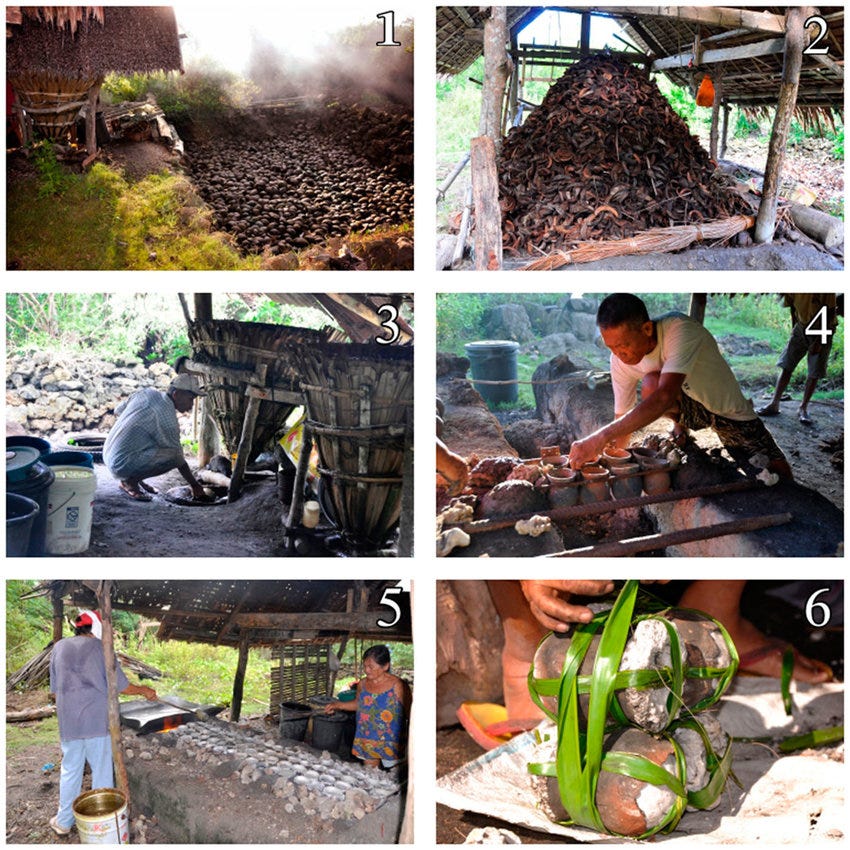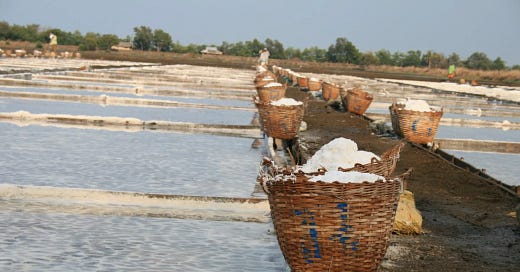The Last Vestiges of Philippine Sea Salt
Can our precolonial culinary tradition last beyond just a memory?
Welcome to the first meryenda Monday of 2022! The days still seem blurry yet I’m comforted by the sunnier mornings, the lengthier days and the steady ease back into writing. Cassandra and I look forward to being welcomed again by your curiosity.
I wanted to write about resolutions, but to be quite honest, I find that a cyclical tempo more suits me— never really focusing on beginnings or endings, but on reflection as things change. This year, we are shifting the pace to monthly issues to make space for subscription perks and project building, along with any surprises that may come along the way. More will be unraveled in the next month.
Let’s dive right into this issue, but before we do, I’d like to familiarize you with some of the terms I’ll be referring to. Let’s familiarize ourselves with the lexicon of Philippine salt-making.
asin (ah-seen) = salt
asinderos = salt-makers
I’d like to think I have a robust selection of condiments in my pantry— chili crisp in varying reds ranging from the quintessential ruby oiled Lao Gan Ma to its more crimson Mexican counterpart salsa macha; a medley of vinegars; Asian stock pastes; and even a mysterious orange and white seasoning box I was given as a bonus from the clerk at a local Thai grocery store who told me, “If you want your food very good, add this. My secret!”
When it comes to salt, I’m loyal to one: sea salt. To be quite honest I’m not even entirely sure which sea it’s from and I suppose I’m loyal because it’s convenient. Ah, convenience, how you blind even the most inquisitive of us. It’s when I rocked out of capitalism’s salty lullaby that I found myself in the ivory tower of salt wonders of the Philippines. Yes, such a world exists! Although it pains me to say we’re at a liminal point, with just a few asinderos the last vestiges of our salt-making traditions. How exactly did salt production in the Philippines become an ailing industry and can our precolonial culinary history last beyond just a memory?
Salty Beginnings
Salt forms in many parts of the world. The ocean seemingly offers an abundant source of salt, but it has, on average, a salinity of only 3.5%. As Andrea Yankowski explains, “This means that for every 100 kilos of water, only 3.5 kilos of salt can be extracted by direct boiling or evaporation, and the process requires significant time and fuel resources.”
Filipinos, particularly in the Visayas (central Philippines), have long practiced innovative salt-making methods. It is through salt and the seas we can begin to reconnect with our past and sharpen our focus on our precolonial traditions.
If you’ve uncovered the pattern laminated in Philippine history, you’ve probably already guessed that the first documented accounts of salt-making came from the Spanish. Perhaps one of the most detailed recordings comes from Father Ignacio Alcina, a Spanish historian and missionary who served in the Visayas for 37 years during the 17th century.
Alcina describes Visayan indigenous customs and traditions in Historia de las islas e indios de Bisayas (which, not surprisingly, is currently out of print and therefore difficult and painfully expensive to get). Luckily, after many desperate twilight chats with online librarians who helped me maneuver through university library access walls, I found Andrea Yankowski. Yankowski is an archaeologist/anthropologist from Berkeley, California who researches extensively on traditional salt production and trade, among other things.
In her 2021 book, Asin Tibuok, which she dedicates to “all the salt-makers of Bohol, past and present,” Yankowski provides Alcina’s original accounts of a salt he described as only found in the central Philippines called “sal de Bisayas.” This method of salt-making produces none other than the salt that has become the recent darling of Philippine food media: asin tibuok or unbroken salt. Alcina’s descriptions provide us context for salt-making in Bohol today:
“When it is time for salt-making (which we have said is the dry season) one or two natives or more if they wish, go down to the sea to find some logs or large trunks of those trees which the waves are accustomed to carry… they are left for a few days to soak in the salt water so that it may penetrate well into the wood through any of those ways.”

He breaks down the process in greater detail below, describing the use of vessels to boil the concentrated seawater to produce an unbroken salt:
“They bring the logs to the shore of the sea and make large piles of heaps of them… they set them on fire and proceed to burn them.”
“Once the logs turn to ashes, they collect them… They fill [containers] with ash. They proceed to pour sea water in them… It is strained… and collected.
“With the heat those balotos or jars briskly burn… the vessel always remains filled. During six or more hours, a very hot fire is continually provided until the lye-water begins to coagulate and hardens… the point is reached when it is completely coagulated, the container full and the salt made.”
We can ride the coattails of asin tibuok to explore the abundance of other salt-making traditions around the archipelago, most of which are concentrated in the Visayas.
A Glimpse into Philippine Salt
Let’s begin at one of the country’s top producers of salt, the place where salt is etched into its name: Pangasinan. The etymology of Pangasinan connotes to a salt-making place, coming from the root word asin meaning salt and affixes pang and an which refer to location. We can see salt’s influence in the region’s expansive vocabulary for asin, which is highlighted below:
In the coastal towns of Dasol and Infanta, salt farming is a family industry. Thousands of salt beds sprawl across the barangays, flashing a kaleidoscopic glimmer at the turn of the season. Here, salt farming begins once summer hits. Pangasinan produces a naturally white, mineral-rich sea salt. With its combination of granular and flake crystals, xroads founder, Lennie Buenaflor DiCarlo, calls it the Philippine flor de sal.
Interestingly, asinderos apply various methods for processing seawater into salt depending on region. Along some coastal areas, such as Pug-os beach in Ilocos Sur, sand is turned into salt.
Miagao in the province of Iloilo is home to what may be one of the more laborious salt farming methods. Here, the local salt is called budbud, meaning “to sprinkle.” Condensing this process in a few short sentences is difficult and warrants its own dedicated issue (which can be done if there is interest!). In short, asinderos use long bamboo poles to carry seawater –some when filled, weigh as much or more than the asindero himself– to sprinkle onto prepared sand so that it becomes concentrated with salt. The prepared sand is piled and sprinkled with more seawater to make a brine, which is collected and left to evaporate in split bamboo. Unique to budbud is the use of a mountain vine called balunos, which formerly was brought down by the Aetas to trade for a sack of budbud. Without the addition of balunos to the brine, the salt does not form into the crystalline texture desired by the Miagawanons.
In the Western Visayas lies Guimaras Island, home to a local salt called tultul. Perhaps what is most interesting with tultul is the way in which it helps eliminate driftwood on the shorelines. This salt method uses dagsa, or plant and tree materials carried to shore by the tides, which are burned into an ash. Because the dagsa has already absorbed seawater, it contains salts which are further concentrated during the salt-making process. Coconut milk is added to the strained concentrated seawater. The finished product is a bareta or salt tablet. As of today, this tradition is kept alive by Serafin and Emma Galina, the last remaining tultul makers on Guimaras.
An Unintended Salt Prohibition
Salt is needed to make patis and bagoong. It’s used for preservation in foods like tuyo (dried fish) and itlog na maalat (salted eggs). It’s used to fertilize coconut trees, considered the “tree of life' in the Philippines. It also provides essential minerals to carabao, the agricultural backbone of the country.
Salt is in the very building blocks of Filipino cooking, yet, the Philippines remains reliant on salt imports. According to the 2020 International Trade Database, the Philippines imported $28.8 million USD worth of salt (up from $24.4 million or 80% of its salt consumption in 2016) with most coming from Australia and China.
Considering this most recent statistic, I found it astounding to learn that the Philippines was once almost entirely self-sufficient on salt. Salt farming was a thriving industry until 1995, when the government enacted the Act for Salt Iodization Nationwide (ASIN) to comply with the World Health Organization to address iodine deficiencies and nutrient malnutrition.
The ASIN law or Republic Act 8172 required “all producers and manufacturers of food-grade salt to iodize the salt that they produce, manufacture, import, trade or distribute.”
While the law meant well, it also unintentionally fractured the livelihood of salt farmers, a majority of whom were unable to meet the new law’s requirements. The ongoing salt restrictions have made it nearly impossible for the local salt industry to rebound. As for the existing salt farms, the question lies in how to make these traditions economically viable while complying with mandatory salt fortification. Today, asinderos are plagued with a growing uncertainty: environmentally as eroding shorelines and an ever-stretching wet season; culturally as loss of interest in the trade.
Salt Beyond Seasoning
One day, Philippine salt can silently fade into another cultural artifact. We’ve lived without Philippine salt all this time so why care now when finely ground salt is conveniently within our reach?
Maybe it’s because I’ve thought about the world I want to live in— one where our food choices don’t branch from the same three mega food corporations and one where we intuitively know where our food is grown. Maybe what I’m asking for seems like a distant, illusory vision— a utopian fantasy. But our current consumption habits have flung us in a precarious trajectory laden with excessive food waste, endangered culinary traditions, labor exploitation, and destruction of our natural world.
Maybe we’re already in a fever dream. Perhaps then, my wonderland doesn’t seem so hysterical. Why care? For those of us hypnotized under the lull of ignorance, maybe the better question is, why not? Because as we’ve come to know, bliss is ignorance’s faithful shadow.
The truth is, we can’t care for what we don’t know. So, what can we do? Pay more attention. Listen. Listen more outside of what’s packaged so neatly for us. Ask questions. Heck, begin with one question! No action is ever too small. After all, a single grain of salt can transform an entire dish.
Current meryenda
The Price of Salt by GRID Magazine







